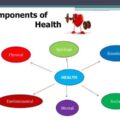Health-related fitness (HRF) is theoretically defined as a multidimensional construct containing the 5 components. Physical fitness is often measured to see if an adequate standard is in place to ensure good health. The general definition of physical fitness is offered by Howley & Franks (2007) as “a state of well-being with a low risk of premature health problems and energy to participate in a variety of physical activities.”
The two types of physical fitness most often identified are health-related physical fitness and skill-related physical fitness. Health-related fitness is characterized by moderate to vigorous physical activity. Health-related fitness is a better match for people who are generally unwilling to exercise at high intensities.
Health-related fitness activities can be integrated into everyday activities that are often characterized as lifetime activities. In contrast, skill-related physical fitness includes health-related components, but it also covers components related to physical performance. Skill-related fitness is the right choice for people who can and want to perform at a high level, but it is less acceptable to most people because it requires training and exercising at high intensities.
What Are The 5 Components Of Health-Related Fitness?
There are five areas of health-related fitness they include;
Heart and lung endurance or cardiovascular endurance: is the ability to exercise the entire body for long periods of time. It requires a strong heart, healthy lungs, and clear blood vessels to supply the body with oxygen. Activities to improve fitness in this area include running, swimming, and aerobic dance. A person must do the activity continuously for a minimum of 20 minutes within their target heart rate zone. Endurance/cardiovascular activity should be done a minimum of 3 days per week. Every other day is preferable. The mile or the pacer will measure fitness testing in this area.
Muscular Strength: is the amount of force you can put forth with your muscles. It is often measured by how much weight you can lift. People with strength have fewer problems with backaches and can carry out their daily tasks efficiently. Examples of muscular strength include push-ups, weight lifting heavyweight with few repetitions, and pull-ups. Fitness testing will be measured by doing push-ups.
Muscular Endurance: is the ability to use the muscles, which are attached to the bones, many times without getting tired. People with good muscular endurance are likely to have better posture, have fewer back problems, and be better able to resist fatigue than people who lack muscular endurance. You can improve muscular endurance by lifting weights with many repetitions or doing sit-ups. Measuring the number of sit-ups you can do correctly is used for fitness testing.
Flexibility: is the ability to use your joints fully. You are flexible when the muscles are long enough and the joints are free enough to allow movement. People with good flexibility have fewer sore and injured muscles. Stretching before and after activities will help to improve flexibility. The sit-and-reach and the trunk lift are two tests used to measure flexibility.
Body Composition: is the percentage of body weight that is fat compared to other body tissue, such as bone and muscle. People who have a high percentage of fat are more likely to be ill and have a higher death rate than lean people. Exercise and eating the right foods in the proper amounts can improve body composition. Body composition can be measured using an instrument called calipers, a specialized scale, or it can be calculated by using the body mass index (BMI) which uses height and weight to determine your BMI.






